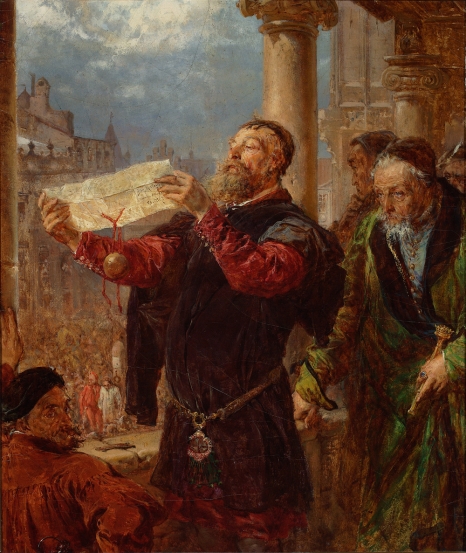
Matejko
20.04 – 10.06 2018,
1 Sandomierska St., Regional Museum in Stalowa Wola invites you to a unique exhibition presenting the works of one of the most famous painters in the history of Poland – Jan Matejko.
The Regional Museum in Stalowa Wola inaugurates the celebrations of the 100th anniversary of Poland regaining independence with an exhibition dedicated to the exceptional painter Jan Matejko. This remarkable artist captivated Polish culture on various levels, and his— as noted by Jarosław Krawczyk—heroic image remains ingrained in the collective imagination. […] He proposed to Poles— in place of the colorful anecdotes of Suchodolski or Kossak— a grand theatrical portrayal of history. On the expansive canvases, the “great cycle” of Polish historical events expands into a dramatic moral tale of sin, penance, and redemption. […] Polish culture long awaited a painter capable of rising to a level comparable to romantic poetry.
The MATEJKO exhibition is also prepared on the occasion of the 180th anniversary of the artist’s birth and the 125th anniversary of his death, as well as the 200th anniversary of the Jan Matejko Academy of Fine Arts in Kraków. Jan Matejko (1838–1893), one of the most important Polish artists, primarily painted historical compositions, creating a vivid and persuasive vision of Poland’s history, including his famous grand historical cycle: The Battle of Grunwald, The Sermon of Skarga, The Prussian Tribute, Kościuszko at Racławice, Batory at Pskov, Sobieski at Vienna, Zamoyski at Byczyna, and many other compositions depicting various episodes of Polish history. He also painted portraits of notable figures and family members. He is the author of polychromies in St. Mary’s Church in Kraków.
Matejko became the director of the School of Fine Arts in 1873, having already gained recognition as a well-known and awarded artist in Europe. Regularly exhibiting at the Paris Salons and winning medals, he entered the realm of official art. In 1895, art history professor Marian Sokołowski astutely noted that none of the European societies valued Matejko as highly as France did. He owed his worldwide fame primarily to Paris, which conferred upon him all the honors usually given to the greatest and most exceptional artists.
His students included Stanisław Wyspiański, Józef Mehoffer, and Jacek Malczewski. On September 28, 1979, the Academy of Fine Arts in Kraków was named after Jan Matejko.
His works were reproduced in various ways: lithographs, woodcuts, and photographs were created, primarily depicting Polish history based on his paintings. As researcher Jarosław Krawczyk aptly noted,
“It seems as though there exists an agenda in Polish culture specialized in domesticating Matejko’s creations, functioning outside the logic and content of individual compositions. […] The degree to which certain representations are rooted in social consciousness is entirely impossible to determine.”
This observation remains relevant today. The exhibition presents over ninety works—oil paintings, drawing sketches, and reproductions of woodcuts and lithographs of his works. In seven thematic spaces—Workshop, History, Religion, St. Mary’s Polychromy, Adam Mickiewicz Monument in Kraków, Portraits, Reception—the phenomenon of Matejko is signaled. The exhibition concludes with a presentation of the work of four rectors of the Kraków Academy of Fine Arts named after Jan Matejko: the current rector, Prof. Stanisław Tabisz, and former rectors: Jan Pamuła, Stanisław Rodziński, and Adam Wsiołkowski.
Among the exhibits are works rarely shown, including depictions of the Virgin Mary from the Treasury of the Pauline Monastery at Jasna Góra, an image of Jan Kochanowski from the Polish Academy of Arts and Sciences in Kraków, and a unique collection of sketches for the album “Costumes in Poland” from the Jagiellonian University Museum.
The exhibition showcases works from the Academy of Arts and Sciences in Kraków, the Dr. Stanisław Fischer Museum in Bochnia, the Pauline Monastery at Jasna Góra, the Historical Museum of the City of Tarnobrzeg, the Lublin National Museum, the National Museum in Warsaw, the National Museum of the Przemyśl Region, the Leon Wyczółkowski District Museum in Bydgoszcz, the District Museum in Rzeszów, the District Museum in Tarnów, the District Museum in Toruń, the Jagiellonian University Museum, the Royal Castle in Warsaw, and private collections.
Scenario and Arrangement: Dr. Anna Król
Coordination on behalf of the Regional Museum in Stalowa Wola: Magdalena Kołtunowicz
Printed materials accompanying the exhibition: Rafał Sosin